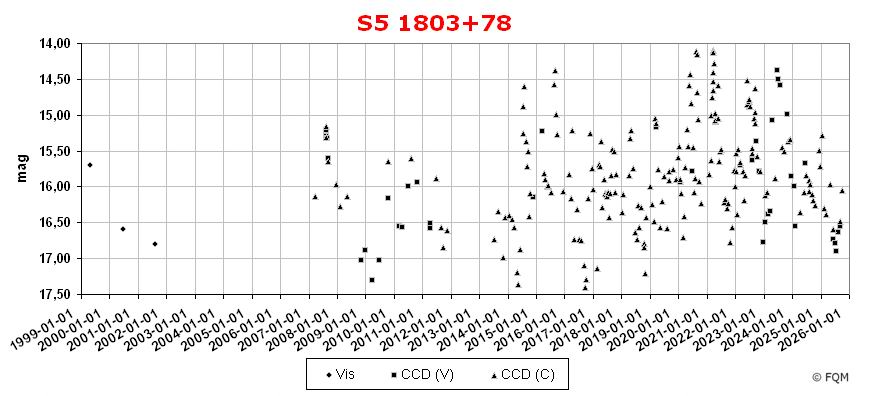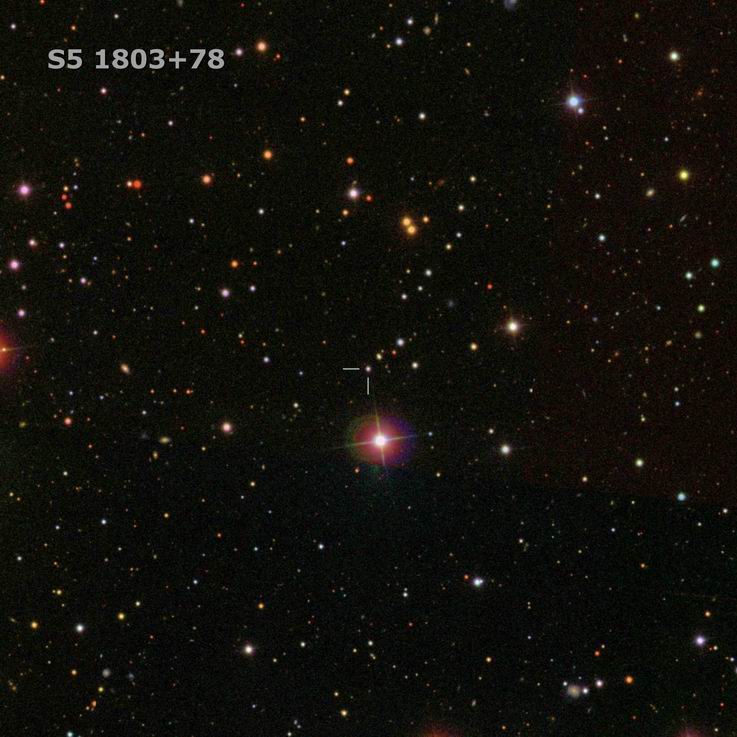
| Frankfurt Quasar Monitoring |
| S5 1803+78 |
| Cross-Identifications | S5 1803+784, 8C 1803+784, QSO B1803+78 IRAS 18036+7827, 1RXS J180043.6+782806 WMAP J1800+7828, 0FGL J1802.2+7827 2MASS J18004568+7828040, 1803+784 1FGL J1800.4+7827, 2E 1803.5+7828 BZB J1800+7828, VSOP J1800+7828 |
| Equat. coordinates | RA 18 00 45.7 DE +78 28 05 (J2000) |
| Constellation | Draco |
| Type | QSO (1) / BL Lac (2) (5) |
| Redshift (1) |
z=0.680 |
| Distance (2) (3) | 2378 Mpc |
| Total mag range (mv) (4) | 14.4 - 17.8 |
| Catalog Magnitude (1) | 15.9 (phot.) |
| Absolute Magnitude (1) | -27.3 MB |
| Light Travel-Time (2) | 6.008 × 109 yrs |
(1) Véron-Cetty & Véron 2006, A&A 455, 776 (2) NASA/IPAC Extragalactic Database (3) Co-Moving Radial Distance (4) Literature (5) CDS Strasbourg Database |

Comparison stars
| star | B | V | Rc | Ic |
| A | 15.39
(0.05) |
14.54
(0.03) |
14.06
(0.03) |
13.62
(0.03) |
| B | 15.97
(0.01) |
15.30
(0.01) |
14.92
(0.01) |
14.53
(0.01) |
| C | 16.37
(0.01) |
15.73
(0.01) |
15.36
(0.01) |
14.97
(0.01) |
| D | ---- |
16.58
(0.01) |
16.08
(0.01) |
15.57
(0.01) |
| E | ---- |
16.49
(0.01) |
16.10
(0.01) |
15.70
(0.01) |


| S5 1803+78 is a violently variable object
located in north-eastern Draco, close to the constellation Ursa Minor. S5 1803+78 was discovered as a strong radio
source in 1977/78 during the 5-Ghz Strong Source Survey (S5). Since
then, this quasar has been cataloged by several other radio surveys. Soon after the discovery, a 17-mag blue stellar object was identified as the
optical counterpart, which turned out to be variable in
both radio and optical wavelengths. S5
1803+78 was
classified as a BL Lac object in 1979 due to its variability and strong
optical polarization. The continuous
optical spectrum showed only a weak emission line, so
the first redshift (z=0.68) was published
in 1987, which was later refined to z=0.680 in 1996 and
2001. A
redshift of z=0.680 corresponds to a light travel time of about 6 Gyrs.
Today, S5 1803+78 is classified as a Flat-Spectrum Radio Source with a
complex core-jet structure. The radio jet extends to the west. Besides the optical and radio, S5 1803+78 is
also known as a source of infrared, X-ray, and also gamma emissions. In the literature, S5 1803+78 has been classified variously as a BL Lac object or as a quasar. For example, S5 1803+78 was classified as a quasar in the quasar catalogs published by Véron-Cetty & Véron in the editions between 2000 and 2010 (Véron-Cetty & Véron (2000-2010)), whereas the same authors classified this object as a BL Lac object in earlier editions of their quasar catalog (e.g. Véron-Cetty & Véron (1998)). S5 1803+78 is a violently variable object with a total range of more than 3 magnitudes in the optical. At maximum, visual observers need at least an 8- to 10-inch telescope to glimpse this stellar object. Even with large instruments S5 1803+78 remains stellar. The light curve above makes clear that this object is a preferred target for CCD observers. Digital observers, as well as visual observers, shall use the comparison stars given above. Another sequence was published by the AAVSO, which uses the same comparison stars as given above. ____________
S5 1803+78 is located in north-eastern Draco, close to the constellation Ursa Minor. For mid-northern observers, this quasar is a circumpolar object. Its position lies right between the 5.0-mag star 35 Dra in the north and the binary 40/41 Dra in the south. Binary 40/41 Dra (STF2308) is a nice and easy target for small telescopes, consisting of a 5.6-mag primary and a 5.9-mag secondary, separated by 19.3". Both components are of type F7. CCD observers are recommended to turn their telescopes some 2.5° to the west. Here we find the bright and rich galaxy cluster Abell 2256, located at a distance of about 800 million light-years. Those observers who like to catch some more extremely old quasi-stellar photons may turn to quasar PG:1634+706, a bright 14-mag object at the whopping distance of about 8.6×109 light-years, located some 9.7° SE of S5 1803+78. PG 1634+706 is one of the most luminous objects known. Another bright 14-mag quasar can be visited about 5.6° SSE of S5 1803+78. Here we find quasar PGC 61965 at a distance of about 1.5×109 light-years. |
| Abdo, A.A., Ackermann, M., et al. 2010, ApJ, 722, 520; Gamma-ray Light Curves and Variability of Bright Fermi- detected Blazars. Biermann, P., Duerbeck, H., et al. 1981, ApJ, 247, 53; Observations of Six Flat Spectrum Sources from the 5 GHz Survey. Burbidge, G., Hewitt, A. 1987, AJ, 93, 1; An Updated List of BL Lac Objects, and their Relation to Galaxies and Quasistellar Objects. Heeschen, D.S., Krichbaum, Th., et al. 1987, AJ, 94, 1493; Rapid Variability of Extragalactic Radio Sources. Kühr, H., Pauliny-Toth, I.I.K., Witzel, A., Schmidt, J. 1981, AJ, 86, 854; The 5-Ghz Strong Source Survey. V. Survey of the Area between Declinations 70° and 90°. Lawrence, C.R., Zucker, J.R., et al. 1996, ApJS, 107, 541L; Optical Spectra of a Complete Sample of Radio Sources. I. The Spectra. Nesci, R., Massaro, E., et. al. 2002, AJ, 124, 53; Optical and Radio Monitoring of S5 1803+784. Nesci, R., Maselli, A., et. al. 2012, arXiv: 1202.0125v1; S5 1803+78 revisted. Strom, R.G., Biermann, F.L. 1991, A&A, 242, 313; 1803+784: A BL Lacertae Object with remarkable Radio Properties. Véron-Cetty, M.-P., Véron, P., 1998, ESO Scientific Report 18; A Catalogue of Quasars and Active Nuclei (8th Edition). Véron-Cetty, M.-P., Véron, P., 2000, ESO Scientific Report 19; A Catalogue of Quasars and Active Nuclei (9th Edition). Véron-Cetty, M.-P., Véron, P. 2001, A&A 374, 92; A Catalogue of Quasars and Active Nuclei: 10th edition. Véron-Cetty, M.-P., Véron, P. 2003, A&A 412, 399; A Catalogue of Quasars and Active Nuclei: 11th edition. Véron-Cetty, M.-P., Véron, P. 2006, A&A 455, 776; A Catalogue of Quasars and Active Nuclei: 12th edition. Véron-Cetty, M.-P., Véron, P. 2010, A&A 518, 10; A Catalogue of Quasars and Active Nuclei: 13th edition. Witzel, A., Schalinski, C.J., et al. 1988, A&A, 206, 245; The Occurrence of Bulk Relativistic Motion in Compact Radio Sources. |
| home |